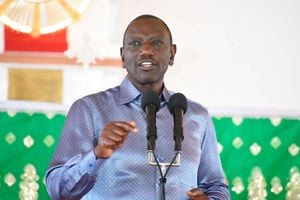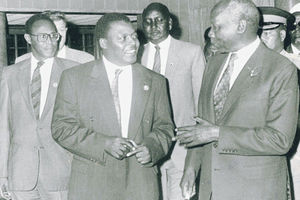
Senators say the multi-billion shilling contracts signed between counties and the national government for lease of medical equipment are illegal
On June 1, 2015, the then Council of Governors chairperson Peter Munya publicly demanded full details of the Medical Equipment Scheme (MES) claiming that governors had not been adequately consulted before the Sh38 billion project was launched.
Mr Munya, who was also the Meru governor at the time, opposed the Ministry of Health government’s health scheme, insisting that county bosses would not proceed until the contracts with the suppliers of the medical equipment set to be leased to counties were made transparent.
“Governors want to be aware of the lease agreement between the national government and the suppliers. The least the national government can do is make that information known to us,” he said during the Madaraka Day celebrations at the Meru National Polytechnic.
His demands at the time underscored the growing tension over the lack of consultation and the unclear terms surrounding the scheme, which would later spark widespread controversy.
But just eight days later, the governors bowed to pressure and agreed to sign the leasing of theatre facilities, dialysis kits, intensive care unit equipment, and X-ray machines in 119 level four and five facilities initiated through a Public Private Partnership (PPP).
The PPP financing arrangement was later terminated in favour of an open international tender to original equipment manufacturers to deliver the equipment in seven lots.
Mr Munya stated that county bosses did not want to be accused of obstructing the provision of better healthcare to the public.
“We decided to offer the government an olive branch. We are willing to sign, and we will sign. I will personally sign the deal so we can move the debate to the next level and move away from the issues of not signing. This is a sign of goodwill and for the good of the general public,” Mr Munya said at a briefing at the CoG headquarters in Nairobi.
Nine years later, the new multibillion-shilling National Equipment Service Project (Nesp) has reignited concerns about the 2015 deal, which ended in scandal and mismanagement.
Just like that scheme, governors, who are responsible for the health function in their counties, assert they were pressured into signing the new deal, a claim the national government strongly refutes.
And just like in the MES programme, the new deal’s critics have taken an about-turn and clarified their comments made both in public and before Parliament.
Nyeri Governor Mutahi Kahiga, who had this week told a parliamentary committee that governors were not involved in the deals and were forced to sign it, on Friday clarified that he only meant that counties were not approached individually.
“The confusion might have come because the Senate was addressing Nyeri as a county, and I said clearly even Kisii, Baringo, and any other county were not involved as a county but through the Council of Governors, which we mandated,” Mr Kahiga, who is also the vice chairman of the council, said in a statement.
“So as of now, as the Vice Chair of the Council of Governors, I say this is the very best programme for us. Now let us stop saying it is shrouded in mystery; it is not.”
The MES programme, which aimed to ensure that Kenyans regardless of their location accessed quality and specialized healthcare was hijacked by a cabal of political operatives and entrepreneurs.
It was the first mega project under the Uhuru Kenyatta-led government after the 2013 General Elections and was rolled out in February 2015, allowing the government to equip hospitals without having the full funds required for procurement of the equipment.
The deal also covered the ongoing maintenance of the equipment without requiring additional servicing and maintenance costs.
The original cost of the programme was Sh43 billion over seven years.
MoH through an international tender advertised in July 2014 invited original equipment manufacturers to supply, install, train users and provide maintenance over a period of seven years with the possibility of an extension for an additional three years.
Contracts under the MES project were signed on February 5, 2015 between MoH and respective service providers.
A September 8, 2020 damning report by an Ad-hoc committee on the controversial MES would later be dismissed by the Senate.
In that deal, the equipping tenders were awarded to General Electric (GE) from the USA, Philips from the Netherlands, Bellco SRL from Italy, Esteem from India, Sysmex Euorope GMBH, and Shenzhen Mindray Biomedical of China.
According to the report, MES implementation encountered many challenges.
“Value for money could not be guaranteed given the inefficiencies of the procurement processes, and the absence of minutes of Inspection and Acceptance Committees. There was also lack of requisite specialised personnel to run the equipment resulting in non-utilisation of some of the equipment,” the report by the nine-member committee chaired by Senator Fatuma Dullo.
The committee found that Ministry of Health officials unilaterally abandoned a deal that would have seen counties pay Sh31 million a year to own the equipment and went for a procurement method that increased the annual cost to Sh200 million.
The document also cited high operational costs with regard to consumables and reagents, lack of infrastructure to absorb equipment by some counties which had not planned nor budgeted for the equipment.
Other challenges listed are binding lease terms requiring quarterly payments despite equipment not being functional in many facilities, lack of sustainability beyond the seven-year contract period and varying of the contract under ‘unclear circumstances “in the 2018/19 FY.
The committee established that those involved in the conceptualisation and implementation of the project from start to finish did so in an irregular and illegal manner violating the constitution.
Criminal enterprise
“The committee established that MES project was a criminal enterprise shrouded in opaque procurement processes and that MoH relied on faulty tool (public sector comparator) to justify a predetermined outcome in relation to the award of tenders that likely results in imprudent use of public finances contrary to Article 201 and Section 197 of the Public Finance Management Act that forbids wasteful expenditure.
The report says some of the equipment was either overpriced, substandard, delivered late or undelivered.
It further fingered MOH for proceeding to procure the equipment despite an earlier needs assessment showing some counties lacked capacity to absorb them fully aware they would be optimally used.
According to the committee, procurement was done “to advance adverse private commercial interests that were supply driven rather than need driven at the expense of the Kenyan public.”
The report said counties were not fully involved in the project conceptualisation and implementation but governors “were still bound by duty to take every reasonable measure to ensure that the equipment was operationalised.”
“Some governors had in contravention of Article 73 violated public trust by abandoning the equipment to a state of disuse by failing either to construct the necessary facilities or to ensure the availability of the required quality or quantity of electrical power and water to ensure utilization of the equipment……thus the full positive of the MES project has not been felt by the people of Kenya,” the report says.
The committee recommended investigations of the tender awards and project implementation by EACC and DCI and a forensic audit by the Auditor General to find out MES’s total cost, deductions by counties and beneficiaries of payments running into billions.
“The audit should also establish under which vote in MoH, MES project funds deducted from counties by the National Treasury are deposited, establish roles by Treasury, Controller of Budget and MoH in the payment processes and determined irregularities and illegalities in the relation to the payments and establish whereabouts of ICU equipment for Meru level five which is still lying in Netherlands,” it said.
The reports says counties did not receive full disclosure on the contracts executed on their behalf by MoH and the contracted companies.
But where successfully implemented, the MES project realised a positive impact on health service delivery through improved access to specialised and emergency care. Also, some counties requested more equipment even though those they had received were not operational or had no qualified personnel to manage them.
MES project
Disbursements towards the MES project were approved By CoB in the absence of explicitly written agreements between the national and county governments.
This was in contravention of the law as due process was not followed in authorising payments. The CoB was fingered for failing to ensure accountable and fair use of public resources in this project.
MoH was put on the spot for ignoring its own findings and recommendations on the lack of specialists to manage the machines.
A report by the ministry considered by the committee noted that more than 10 counties did not have even one specialist but still went ahead to fast track the roll out of MES despite their own assessment showing lack of experts.
“Lack of specialised personnel to operate the equipment has since been identified as one of the key challenges hindering the successful implementation of the MES project,” the report states.
The ministry is accused of blanket allocation of various equipment across counties despite findings showing they were available in at least 65 percent of the facilities.
“In Laikipia, functional X-ray and theatre equipment that had been procured by the national government prior to devolution had to be removed to make way for a new XRay supplied under MES,” the committee noted.
In some counties, equipment supplied under the MES programme remained unused even as the committee began its inquiry in 2019. Theatre equipment was non-functional in Tana River, Wajir, Elgeyo Marakwet, Trans Nzoia, West Pokot, Vihiga, Murang’a, Samburu, and Machakos.
Digital X-ray services were unavailable in 16 counties due to the lack of three-phase electricity. These counties included Siaya, Elgeyo Marakwet, Isiolo, Tana River, Kisii, West Pokot, Migori, Nyamira, Mombasa, Makueni, Kitui, Bomet, Meru, Tharaka Nithi, and Trans Nzoia.
Despite these challenges, payments for the equipment in affected counties continued. The committee highlighted discrepancies between the functionality of the MES equipment as reported by the Ministry of Health and the actual situation on the ground. The report also exposed significant disparities in the implementation of the project across and within counties.
On value for money, the committee found that the equipment was procured in bundles or “Lots” without detailed breakdowns for individual components. This lack of transparency in pricing allowed the Ministry of Health to obscure the true value of the equipment and inflate costs.The report says the cost was “grossly exaggerated












